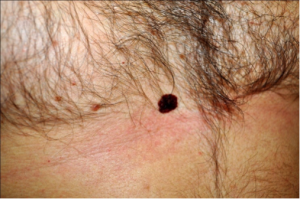Skin self examination
Skin self-examination is checking one’s own skin from head to toe for suspicious lesions, including changes in existing moles and the development of new moles. You can play a vital role in early detection of melanoma through regular skin self-examination. This is one of the most effective ways to find melanoma in its early, most treatable stages. It is important to examine your skin once every month. You might find the ABCDE rule and the ugly duckling sign helpful in differentiating moles from melanoma. Whenever you are in doubt, consult your doctor. The purpose of self-examination of the skin is to detect a new melanoma early.
Doing skin self-examination takes 5 to 10 minutes. It is best done in a well-lit room in front of a full-length mirror so that you can see areas outside of your normal range of vision. It requires privacy to fully undress. You will need a second hand-held mirror for areas that are hard to see.
Many people find it convenient to do skin self-examination before or after bathing or showering. A partner, close friend or family member may be able to help you. Of course this has to be the same person all the time. You have to check every part of your skin.




First, examine your body front and back. Raise your arms and look at the right and left sides of your body. Women should look under their breasts.
Bend elbows and look carefully at your arms and armpits. Check your hands, palms and in between all your fingers. Don’t forget to examine your nails.
Look at the backs of your legs and behind your knees. Check the soles of your feet and in between your toes. Examine your face, neck and entire scalp. It is best to use both a hand-held mirror and a full-length mirror, along with a comb or a blow dryer to better see all areas of your scalp. For the scalp examination in particular you might want to ask somebody to assist you. Finally, check your buttocks, groin area and genitals. A hand held mirror is helpful for hard to see areas.
It is helpful to check your skin the same way each time so you don’t miss any part of your body. It helps to know where your moles and birthmarks are and what they look like. If you check your skin regularly, you will start to learn what is normal for you. It’s important to look for changes to existing moles and appearance of new moles when you do the self-exam.
Existing moles should not become bigger, change in colour or shape, itch, sting or hurt, have scabs or bleed. Melanoma may also appear as a new mole. It may be black, abnormal, or “ugly-looking.” It is important to know the difference between melanoma and a harmless mole.
A normal mole is most often an evenly colored brown, tan, or black spot on the skin. It can be either flat or raised. It can be round or oval. Moles are usually less than 6 mm in diameter (about the size of a pencil eraser) but they could be bigger. Moles can be present at birth or they can appear later. Once a mole has developed, it will usually stay the same size, shape, and color for many years. Moles may fade away in older people. Most people have moles, and almost all moles are harmless.
ABCDE rule
The ABCDE rule is an easy guide to help detect the usual signs of melanoma.

Asymmetry – one half of the pigment lesion does not match the other half.
Border – the edges of the mole are uneven or blurred.
Colour – melanoma can be more than one colour. It can contain shades of tan, brown, red and black. They can also have areas that appear to be blue or white.
Diameter – a pigment lesion is wider than 6 mm (about the size of a pencil eraser or larger).
Evolution – a pigment lesion is changing in size, colour or shape.
Relying solely on the ABCDE rule may result in overlooking melanomas that are smaller than 6 mm in diameter or lack the ABCDE criteria.
Other warning signs of melanoma can be a pigment lesion that looks scaly, bleeds or oozes. It may be itchy or painful. Look for streaks of brown or black under a nail. A dermatologist should evaluate any suspicious findings without delay.
Ugly duckling sign
 Moles in the same individual tend to look similar to one another, and melanoma often looks different and stands out. It could be larger and darker than the surrounding moles. It could be a small light lesion amongst a sea of large dark moles. The ugly duckling is the single pigment lesion that at a given moment in time sticks out from the rest of the moles, it looks or feels different, or changes differently than other moles. If you spot an ugly duckling lesion, see a dermatologist without delay.
Moles in the same individual tend to look similar to one another, and melanoma often looks different and stands out. It could be larger and darker than the surrounding moles. It could be a small light lesion amongst a sea of large dark moles. The ugly duckling is the single pigment lesion that at a given moment in time sticks out from the rest of the moles, it looks or feels different, or changes differently than other moles. If you spot an ugly duckling lesion, see a dermatologist without delay.